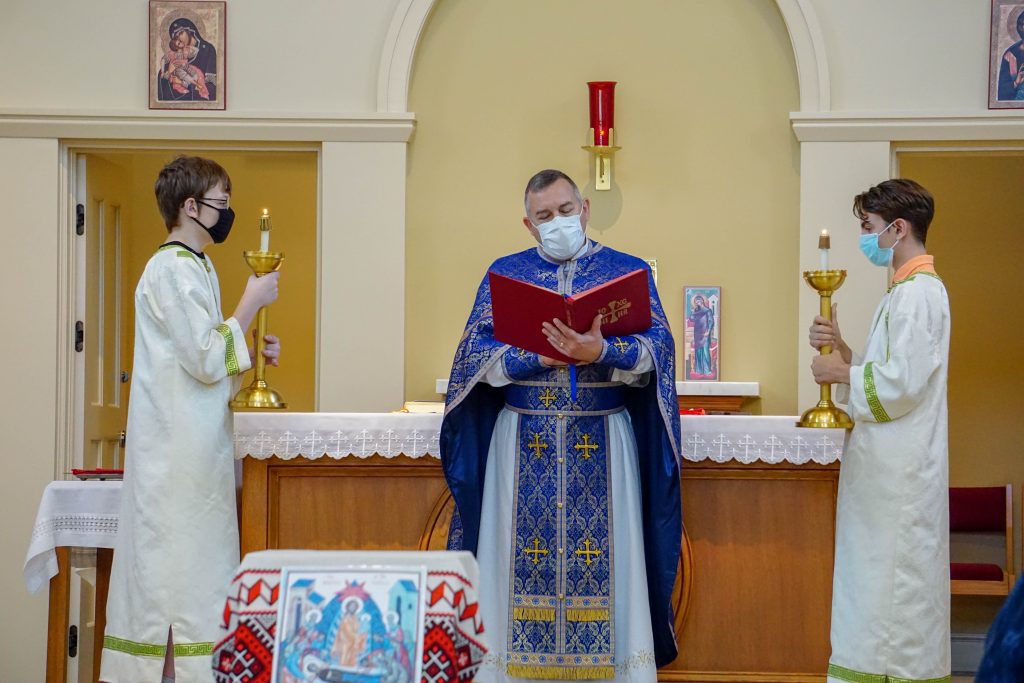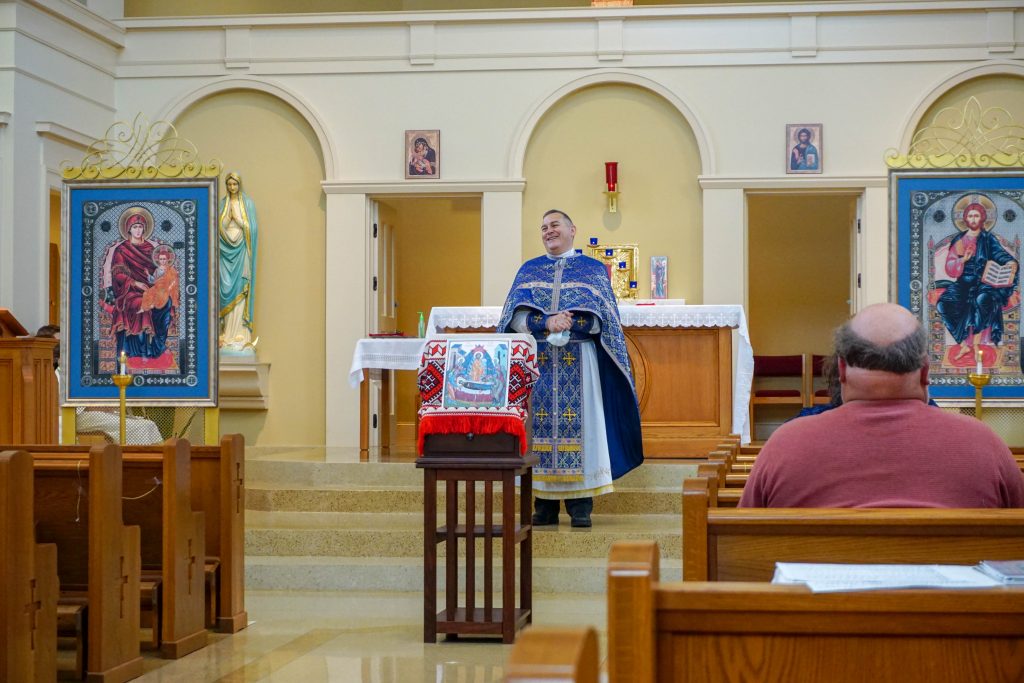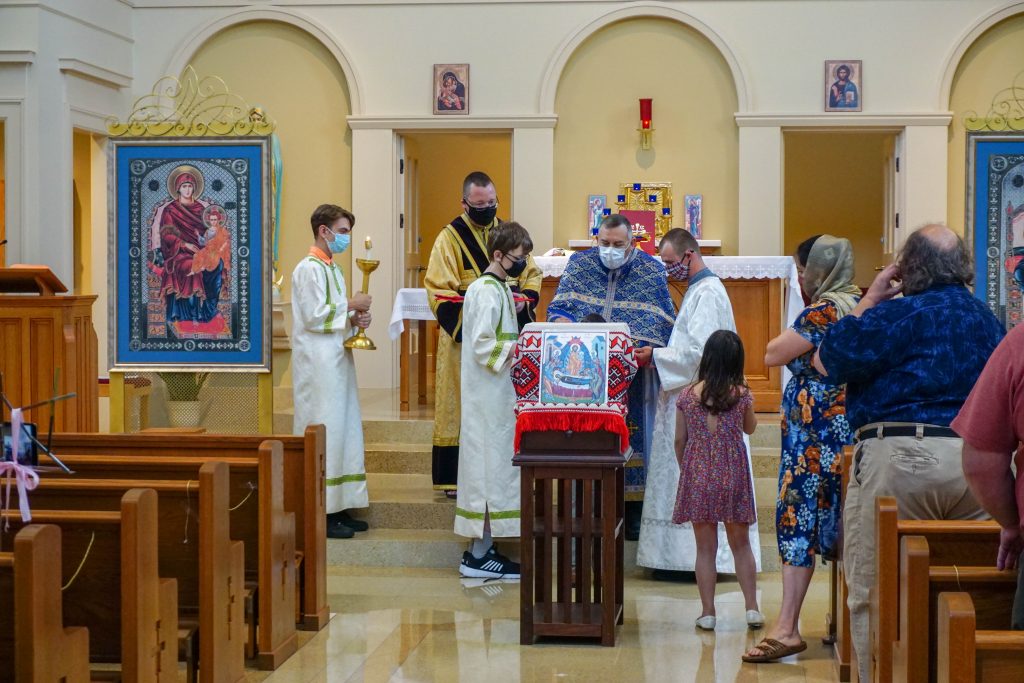August 24, 2020 // Diocese
‘Breathe with both lungs’: the beauty of worshipping in Eastern and Western Catholic traditions
Most people are familiar with the Western Catholic Church, specifically Roman Catholic. But within the universal Catholic Church, which includes Eastern and Western churches, there are a variety of rites — six, in fact — who are in communion with the Bishop of Rome and take their own distinct approaches to celebrating the sacraments. These rites include the Alexandrian, Armenian, Byzantine, East Syrian, Latin and West Syrian.
St. Andrew the Apostle Mission Parish in Fort Wayne worships under the Byzantine rite of the Eastern Catholic Church. Father David Meinzen, a priest of the Ukrainian Catholic Eparchy of Chicago, presides over St. Andrew’s Divine Liturgy celebration — the Byzantine rite’s name for its eucharistic services.

Photos by Annie Obergefell
Father David Meinzen gives a homily on the Gospel story of Jesus at the home of Mary and Martha. The iconography on the right and left are brought into the St. Francis Chapel in Fort Wayne specifically for the Eastern Catholic services.
The Roman and Byzantine rites emphasize different aspects of Jesus Christ’s human and divine nature. Father Meinzen explained: “At the risk of overgeneralizing, the Western Church’s Roman Rite, characterized by liturgical brevity, well emphasizes the divine condescension in the humility of Jesus Christ to be with us and redeem fallen humanity and creation, while the Eastern, Byzantine Rite, characterized by more expansive liturgical expression, tends to highlight the revelation of divine glory, elevating our humanity and all creation in Christ Jesus. But again, such emphases are not exclusive, and both rites truly celebrate all of this.”
St. Andrew celebrates the Divine Liturgy at the Oratory of St. Francis of Assisi, located on the campus of the University of Saint Francis.
As an Air National Guard and Veteran’s Administration chaplain, Father Meinzen celebrates both Roman and Byzantine rites. This rounded experience allows him to witness the beauty and completeness of the Eastern and Western Catholic traditions.
“The Catholic Church as a whole is a family of churches centered on the unifying charism given to the Bishop of Rome, but not all churches follow the exact same practices,” Father Meinzen said. “They take slightly different approaches in practicing the canon law, but they harmonize.
“We’re a sister tradition. We want our Roman Catholic brothers and sisters to have the opportunity to do what Pope St. John Paul II said — to breathe with both lungs by experiencing both Eastern and Western Catholicism.”

Father Meinzen gives a homily on the Gospel story of Jesus at the home of Mary and Martha. The iconography on the right and left are brought into the St. Francis Chapel in Fort Wayne specifically for the Eastern Catholic service.
The seeds for St. Andrew were planted back in 2008 by Dr. Adam DeVille, subdeacon and director of the Division of Humanities at the University of Saint Francis. DeVille, a member of the Eastern Catholic Church, moved to Fort Wayne in 2007. He had personally known a priest who drove from Mishawaka to Fort Wayne to celebrate the Divine Liturgy for an earlier Eastern Catholic mission parish founded in 1967. This original mission parish dissolved, but a plaque commemorating the congregation still exists today in the St. Mother Theodore Guérin Chapel in downtown Fort Wayne.
DeVille wrote an article in Today’s Catholic to find out if anyone in the area remembered the original community or would be interested in forming a new worship group. Erin Kauffman, an Eastern Catholic who would later become the secretary at St. Andrew, read DeVille’s article and took it as the sign she’d been looking for. She and DeVille started hosting prayer services at their homes. After receiving approval from the Eparchy of Chicago and Bishop Kevin C. Rhoades of the Diocese of Fort Wayne-South Bend, Father Meinzen was assigned to the mission parish — meaning that it was “in formation” — and led its first Divine Liturgy celebration in 2011.
Typical of Church history, the reasons as to why the Catholic Church expanded into Eastern and Western factions are complex. One of the first major events occurred in 1054. Known as the Great Schism, the patriarch of Constantinople and the representative of the pope of Rome excommunicated each other. Although both the Eastern and Western Churches believe the pope should be “first among equals,” disagreements over the role of the papacy persisted, in addition to conflicts such as using unleavened or leavened bread for the Eucharist.
Father Meinzen, DeVille and Kauffman all reiterate how the Eastern and Western Catholic Church complement each other in their differences of emphasis. During St. Andrew’s Divine Liturgy celebration, most of the service is sung with a special focus on prayer psalmody drawn from Scripture. Another difference of emphasis is that, whereas the Western Catholic Church in the modern era tends to take a more scholastic approach — referencing writings from the doctors of the Church for doctrinal discussion and education before tapping into liturgical texts and symbolic art and actions — the Eastern Catholic Church tends to reverse this priority. This partly explains why the Eastern Church relies so heavily upon iconographic depictions of religious figures in its art for prayer, carefully shaped according to canons of historical orthodox doctrine and not just from any person’s whim of artistic self-expression.

Parishioners line up to receive holy Communion at St. Andrew the Apostle Mission Parish’s Divine Liturgy celebration at the St. Francis Oratory in Fort Wayne Sunday, Aug. 16. The body and blood of Christ are mixed together in a cup and consumed using a spoon placed on the tongue. Father Meinze and Dr. Adam DeVille, in gold, preside over the service.
For the Eucharist, the Eastern Church uses leavened (or risen) bread, representing the resurrection of Jesus, while the Western Church uses unleavened bread, emphasizing Jesus’ fulfillment of the Old Testament in the Last Supper. Eastern and Western Catholics who have received their first Communion sacrament are able to participate fully in either eucharistic service.
Eastern Catholic Churches that remained in or came back into communion with the Latin Church believe these differences do not divide the two.
With church names like Ukrainian Catholic or Greek Catholic, many practicing Western Catholics assume they need to be Ukranian or Greek to be welcomed into Eastern Catholic parishes. Kauffman, DeVille and Father Meinzen are hoping to change that perception.
“How the Lord gives distinct diversity and unity is incredibly impressive,” said Father Meinzen. “The more Eastern and Western Catholics embrace the freedom of worship, the more it can teach us how Christ is guiding us in all of it.”
St. Andrew the Apostle Mission Parish celebrates Divine Liturgy on Sundays at 11 a.m. at St. Francis Oratory. All are welcome. Visitors are reminded that social distancing is in place and masks are required. For the most up-to-date information, visit the parish’s Facebook page at https://www.facebook.com/St.Andrew.Mission.Parish.
The best news. Delivered to your inbox.
Subscribe to our mailing list today.






